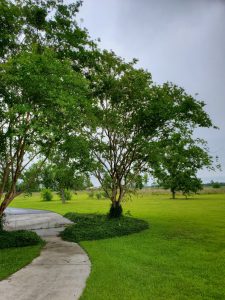Crape Myrtle season is almost upon us. Soon, every roadside, landscape, and gas station parking lot in the deep south will be lit up in gaudy colors from white to hot pink to fire engine red. A well-placed Crape Myrtle (Lagerstroemia hybrids) can turn even the most boring landscape into a picturesque photo op once summer rolls around. These toughest of flowering trees also ask very little of gardeners to look their best, thriving in many varied settings with a wide range of care given to them. Despite their low-maintenance nature, I see all too many Crape Myrtles languishing in landscapes. While it is difficult to fail with Crape Myrtles, it is not impossible if you site and maintain the trees incorrectly. This summer, follow these three tips to get the most out of the best small tree a southern landscape can offer.
- Do not murder your Crape Myrtles. For any reason. No other tree gets lopped off each year to a random height in the belief that it makes it prettier. While your “murdered” crape may indeed produce more flowers the following season, you are permanently damaging the tree, giving rot and decay a foothold, unnecessarily making the tree more susceptible to storm damage, and ultimately shortening the tree’s lifespan. The only pruning that should be done to the species is an occasional “limbing-up” to expose the gorgeous flaky bark underneath and to remove dead or dying branches.
- Don’t plant Crape Myrtles in shade. Crape Myrtles perform their best in 6+ hours of blistering full sun per day. Even light shade at various times during the day will greatly reduce flowering, cause the tree to appear thin, and force it to reach for the sun, creating a leggy look. There are many wonderful small landscape trees like Greybeard, Redbud, and Japanese Magnolia that make excellent Crape Myrtle alternatives in shady sites. If you can’t put a Crape in full sun, plant something else.
- Keep the area under the canopy free of turfgrass. Turf is a wonderful feature in lawns, just not directly under crape myrtles. Grass does an excellent job of scavenging nutrients and water that otherwise would benefit the crape myrtle above. Also, having grass inside the dripline forces homeowners and landscape professionals to cut the grass right up to the trunk. This often leads to soil compaction from heavy mower traffic and damage from lawnmower decks and string trimmers, which damages the thin Crape Myrtle bark and can even girdle and kill the tree. Either kill out the grass and weeds under the canopy with a nonselective herbicide like Glyphosate and then mulch or plant a shade loving groundcover like Asiatic Jasmine.
Crape Myrtle is one of the most rewarding plants Panhandle gardeners can grow as well as one of the easiest. By following just a few best practices, not overpruning, planting only in full sun and keeping the ground free of turfgrass under the canopy, pretty much every landscape can enjoy success with the species. For more information on growing Crape Myrtle and other gardening topics, reach out to your local UF/IFAS County Extension office! Happy Gardening!
- Doveweed Control in Centipedegrass Lawns & Landscaped Beds - June 5, 2025
- Another Plea to End Crape Murder - April 21, 2025
- Roadside Red Blooms – Red Maples Showing Off This Spring - March 6, 2025

